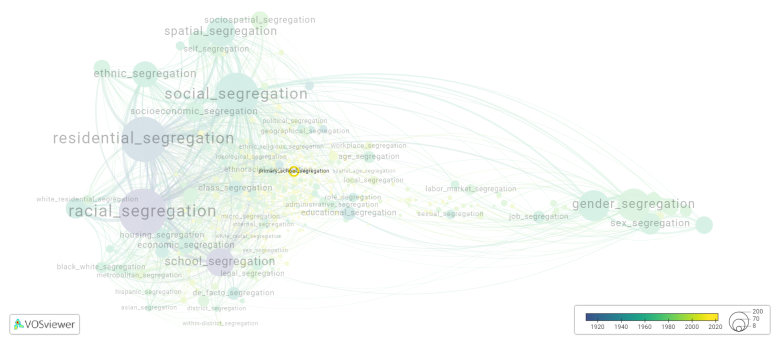Primary school segregation: Difference between revisions
(Creating page) |
(Creating page) |
||
| (One intermediate revision by the same user not shown) | |||
| Line 20: | Line 20: | ||
[[File:primary_school_segregation.png|780x780px]] | [[File:primary_school_segregation.png|780x780px]] | ||
This visualization is based on the study [[Segregation_Wiki:About| The Multidisciplinary Landscape of Segregation Research]]. | |||
For the complete network of | For the complete network of interrelated segregation forms, please refer to: | ||
* | * [https://tinyurl.com/2235lkhw First year of publication] | ||
* | * [https://tinyurl.com/2d8wg5n3 Louvain clusters] | ||
* | * [https://tinyurl.com/223udk5r Betweenness centrality] | ||
* | * [https://tinyurl.com/244d8unz Disciplines in which segregation forms first emerged (Scopus database).] | ||
==References== | ==References== | ||
==Notes== | ==Notes== | ||
Latest revision as of 07:17, 16 October 2024
Date and country of first publication[1][edit | edit source]
2022
United Kingdom
Definition[edit | edit source]
Primary school segregation refers to the practice of separating students based on various factors, such as race, ethnicity, or socioeconomic background, in primary schools. This practice is typically seen in societies where there is a significant divide or inequality among different groups.
Historically, primary school segregation has been prevalent in many countries, particularly during periods of racial or ethnic tension. For example, during the era of racial segregation in the United States, African American students were often denied access to the same educational opportunities as their white counterparts. This led to the establishment of separate schools for black children, which were often underfunded and inferior in terms of resources and quality of education.
Segregation in primary schools can have detrimental effects on students. It perpetuates social and economic inequalities, as children from disadvantaged backgrounds are typically concentrated in under-resourced schools. This results in a lack of access to quality education and opportunities, ultimately widening the achievement gap between different groups.
In recent years, there has been a growing recognition of the harmful impacts of primary school segregation, and efforts have been made to promote inclusive education. Many countries have implemented policies to promote integration and diversity in schools, aiming to provide equal educational opportunities for all children. This includes initiatives such as busing programs, affirmative action policies, and the establishment of magnet schools to attract students from different backgrounds.
Despite these efforts, primary school segregation still persists in some regions. Socioeconomic disparities, residential segregation, and cultural preferences can contribute to the perpetuation of segregated schools. Addressing primary school segregation requires a comprehensive approach that tackles the underlying structural factors and promotes inclusive education for all students, regardless of their background.
See also[edit | edit source]
Related segregation forms[edit | edit source]
Primary school segregation is frequently discussed in the literature with the following segregation forms:
social segregation, socioeconomic segregation

This visualization is based on the study The Multidisciplinary Landscape of Segregation Research.
For the complete network of interrelated segregation forms, please refer to:
References[edit | edit source]
Notes[edit | edit source]
- ↑ Date and country of first publication as informed by the Scopus database (December 2023).
At its current state, this definition has been generated by a Large Language Model (LLM) so far without review by an independent researcher or a member of the curating team of segregation experts that keep the Segregation Wiki online. While we strive for accuracy, we cannot guarantee its reliability, completeness and timeliness. Please use this content with caution and verify information as needed. Also, feel free to improve on the definition as you see fit, including the use of references and other informational resources. We value your input in enhancing the quality and accuracy of the definitions of segregation forms collectively offered in the Segregation Wiki ©.
Primary school segregation appears in the following literature[edit | edit source]
Gorard S., Siddiqui N., See B.H. (2022). Assessing the impact of Pupil Premium funding on primary school segregation and attainment. Research Papers in Education, 37(6), 992-1019. Routledge.https://doi.org/10.1080/02671522.2021.1907775
